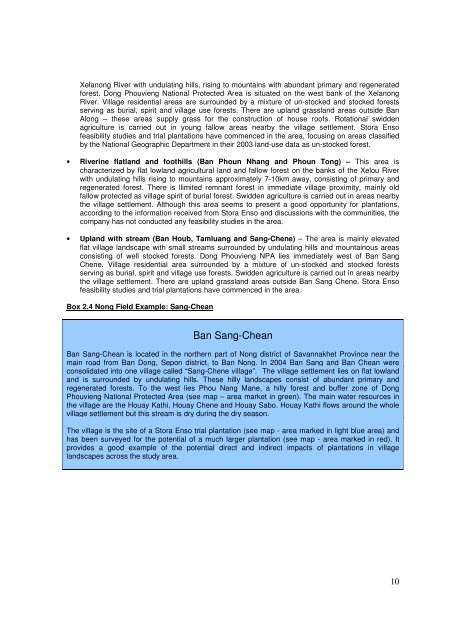Part 1 – A Rapid Participatory Biodiversity Assessment - IUCN
Part 1 – A Rapid Participatory Biodiversity Assessment - IUCN
Part 1 – A Rapid Participatory Biodiversity Assessment - IUCN
You also want an ePaper? Increase the reach of your titles
YUMPU automatically turns print PDFs into web optimized ePapers that Google loves.
Xelanong River with undulating hills, rising to mountains with abundant primary and regenerated<br />
forest. Dong Phouvieng National Protected Area is situated on the west bank of the Xelanong<br />
River. Village residential areas are surrounded by a mixture of un-stocked and stocked forests<br />
serving as burial, spirit and village use forests. There are upland grassland areas outside Ban<br />
Along <strong>–</strong> these areas supply grass for the construction of house roofs. Rotational swidden<br />
agriculture is carried out in young fallow areas nearby the village settlement. Stora Enso<br />
feasibility studies and trial plantations have commenced in the area, focusing on areas classified<br />
by the National Geographic Department in their 2003 land-use data as un-stocked forest.<br />
• Riverine flatland and foothills (Ban Phoun Nhang and Phoun Tong) <strong>–</strong> This area is<br />
characterized by flat lowland agricultural land and fallow forest on the banks of the Xelou River<br />
with undulating hills rising to mountains approximately 7-10km away, consisting of primary and<br />
regenerated forest. There is llimited remnant forest in immediate village proximity, mainly old<br />
fallow protected as village spirit of burial forest. Swidden agriculture is carried out in areas nearby<br />
the village settlement. Although this area seems to present a good opportunity for plantations,<br />
according to the information received from Stora Enso and discussions with the communities, the<br />
company has not conducted any feasibility studies in the area.<br />
• Upland with stream (Ban Houb, Tamluang and Sang-Chene) <strong>–</strong> The area is mainly elevated<br />
flat village landscape with small streams surrounded by undulating hills and mountainous areas<br />
consisting of well stocked forests. Dong Phouvieng NPA lies immediately west of Ban Sang<br />
Chene. Village residential area surrounded by a mixture of un-stocked and stocked forests<br />
serving as burial, spirit and village use forests. Swidden agriculture is carried out in areas nearby<br />
the village settlement. There are upland grassland areas outside Ban Sang Chene. Stora Enso<br />
feasibility studies and trial plantations have commenced in the area.<br />
Box 2.4 Nong Field Example: Sang-Chean<br />
Ban Sang-Chean<br />
Ban Sang-Chean is located in the northern part of Nong district of Savannakhet Province near the<br />
main road from Ban Dong, Sepon district, to Ban Nong. In 2004 Ban Sang and Ban Chean were<br />
consolidated into one village called “Sang-Chene village”. The village settlement lies on flat lowland<br />
and is surrounded by undulating hills. These hilly landscapes consist of abundant primary and<br />
regenerated forests. To the west lies Phou Nang Mane, a hilly forest and buffer zone of Dong<br />
Phouvieng National Protected Area (see map <strong>–</strong> area market in green). The main water resources in<br />
the village are the Houay Kathi, Houay Chene and Houay Sabo. Houay Kathi flows around the whole<br />
village settlement but this stream is dry during the dry season.<br />
The village is the site of a Stora Enso trial plantation (see map - area marked in light blue area) and<br />
has been surveyed for the potential of a much larger plantation (see map - area marked in red). It<br />
provides a good example of the potential direct and indirect impacts of plantations in village<br />
landscapes across the study area.<br />
10

















